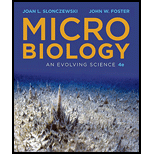
Concept explainers
To review:
The basis of dark-field, phase-contrast, and fluorescence microscopy and their applications.
Introduction:
The evolution and development of different types of microscopy originate from the simple single-lens microscope. The necessity to observe key intracellular and extracellular structures in greater detail led to the development of various kinds of microscopes. While each of them differs in terms of their use and application, the basic principles of light refraction and scattering are the same in each design.
A spider light stop is used inside the condenser lens of the dark field microscope. This spider light stop is used to detect the light that is scattered by an object. This enables the observance of objects as halos of bright light against the dark background. This technique is widely used in detecting special bacterial features like flagella and thus, bacterial motility.
The phase-contrast microscope utilises the difference in the refractive index between the inner part of cytoplasm and the surrounding medium or organelles. An annular ring near the light source is used allowing the detection of light refracted from the specimen and the outer cone of transmitted light. The eukaryotic organisms that possess numerous organelles can be effectively detected by this technique of microscopy.
Fluorescence microscopy utilises coloured fluorophore dyes that bind to the targeted specimen. They absorb and emit light at different wavelengths that are detected on a computerised screen and the output is controlled by the colour of the wavelength filter used. It is used to track events like deoxyribose
Want to see the full answer?
Check out a sample textbook solution
Chapter 2 Solutions
Microbiology: An Evolving Science (Fourth Edition)
- What is behavioral adaptarrow_forward22. Which of the following mutant proteins is expected to have a dominant negative effect when over- expressed in normal cells? a. mutant PI3-kinase that lacks the SH2 domain but retains the kinase function b. mutant Grb2 protein that cannot bind to RTK c. mutant RTK that lacks the extracellular domain d. mutant PDK that has the PH domain but lost the kinase function e. all of the abovearrow_forwardWhat is the label ?arrow_forward
- Can you described the image? Can you explain the question as well their answer and how to get to an answer to an problem like this?arrow_forwardglg 112 mid unit assignment Identifying melting processesarrow_forwardGive only the mode of inheritance consistent with all three pedigrees and only two reasons that support this, nothing more, (it shouldn't take too long)arrow_forward
- Oarrow_forwardDescribe the principle of homeostasis.arrow_forwardExplain how the hormones of the glands listed below travel around the body to target organs and tissues : Pituitary gland Hypothalamus Thyroid Parathyroid Adrenal Pineal Pancreas(islets of langerhans) Gonads (testes and ovaries) Placentaarrow_forward
 Principles Of Radiographic Imaging: An Art And A ...Health & NutritionISBN:9781337711067Author:Richard R. Carlton, Arlene M. Adler, Vesna BalacPublisher:Cengage Learning
Principles Of Radiographic Imaging: An Art And A ...Health & NutritionISBN:9781337711067Author:Richard R. Carlton, Arlene M. Adler, Vesna BalacPublisher:Cengage Learning Biology (MindTap Course List)BiologyISBN:9781337392938Author:Eldra Solomon, Charles Martin, Diana W. Martin, Linda R. BergPublisher:Cengage LearningSurgical Tech For Surgical Tech Pos CareHealth & NutritionISBN:9781337648868Author:AssociationPublisher:Cengage
Biology (MindTap Course List)BiologyISBN:9781337392938Author:Eldra Solomon, Charles Martin, Diana W. Martin, Linda R. BergPublisher:Cengage LearningSurgical Tech For Surgical Tech Pos CareHealth & NutritionISBN:9781337648868Author:AssociationPublisher:Cengage Concepts of BiologyBiologyISBN:9781938168116Author:Samantha Fowler, Rebecca Roush, James WisePublisher:OpenStax College
Concepts of BiologyBiologyISBN:9781938168116Author:Samantha Fowler, Rebecca Roush, James WisePublisher:OpenStax College





